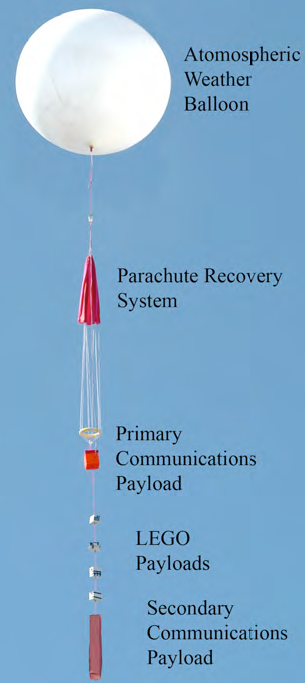 Image Added Image Added
About the ProjectFlight 1, which launched on 10 April 2011, was conceived to celebrate the 50th anniversary of human spaceflight (12 April 2011). This was a proof-of-concept launch, which included a light-weight payload, but still returned some stunning pictures. The project team was delighted with the results. It proved that with the right planning and preparation, you can launch and recover a payload above New Zealand's thin landmass. Science Education Image Added KiwiSpace is now exploring options to develop an education programme using the balloons. Image Added KiwiSpace is now exploring options to develop an education programme using the balloons.
Balloons are a reasonably cheap way to launch payloads to very high altitudes, and while our first launch was focussed on capturing images, there is a lot of science that can be performed. Future missions are likely to contain science instruments or experiments. These can be simple, such as temperature and air pressure, or more advanced - including microgravity experiments for during the balloon's freefall. KiwiSpace hopes to work with schools to get students involved with contributing experiments or improving the balloon electronics and design. As shown in the picture on the right (source), multiple payload bays can be suspended from the balloon, allowing different schools or classes to contribute experiments. In addition, the sciences involved with forecasting weather, flight path and landing location, and radio/GPS tracking provide plenty of opportunities to engage students. We hope to work with teachers to integrate this fun activity into their existing curriculum, so they can really inspire students about science. Expressions of InterestTeachers or Students – if you are interested in getting involved with a future balloon launch, or contributing an experiment, please Contact Us. | Wiki Markup |
|---|
!EOS:A Balloon Mission to the Edge of Space^masthead.gif|width=700,height=160,hspace=10!
{panel}
Browse sections: *[Home|EOS:A Balloon Mission to the Edge of Space]* | *[Photos]* | *[Videos]* | *[Flight Path]* | *[The Payload]* | *[About the Project]*
{panel}
h2. About the Project
*Flight 1, which launched on 10 April 2011, was conceived to celebrate the 50th anniversary of human spaceflight (12 April 2011).* This was a proof-of-concept launch, which included a light-weight payload, but still returned some stunning pictures. The project team was delighted with the results. It proved that with the right planning and preparation, you can launch *and recover* a payload above New Zealand's thin landmass.
h4. Science Education
!balloon_multiple_payloads.png|width=140px,hspace=20px,align=right! *KiwiSpace is now exploring options to develop an education programme using the balloons.*
Balloons are a reasonably cheap way to launch payloads to very high altitudes, and while our first launch was focussed on capturing images, there is a lot of science that can be performed. Future missions are likely to contain science instruments or experiments. These can be simple, such as temperature and air pressure, or more advanced - including microgravity experiments for during the balloon's freefall.
KiwiSpace hopes to work with schools to get students involved with contributing experiments or improving the balloon electronics and design. As shown in the picture on the right ([source|http://thenxtstep.blogspot.com/2008_07_01_archive.html]), multiple payload bays can be suspended from the balloon, allowing different schools or classes to contribute experiments. In addition, the sciences involved with forecasting weather, flight path and landing location, and radio/GPS tracking provide plenty of opportunities to engage students. We hope to work with teachers to integrate this fun activity into their existing curriculum, so they can really inspire students about science.
h4. Expressions of Interest
Teachers or Students -- if you are interested in getting involved with a future balloon launch, or contributing an experiment, please [PORTAL:Contact Us].
| 